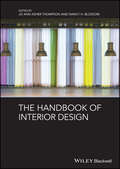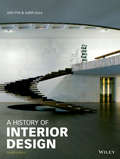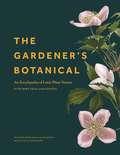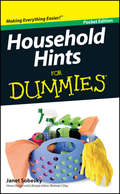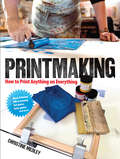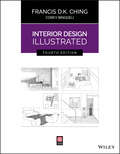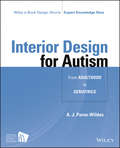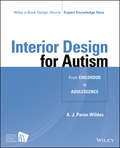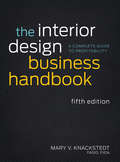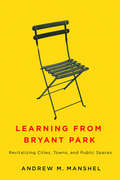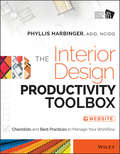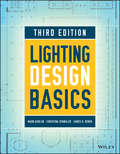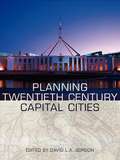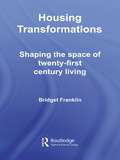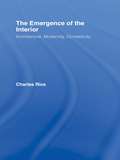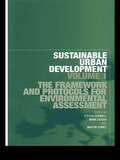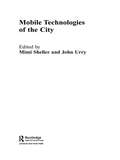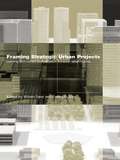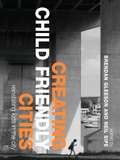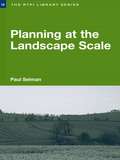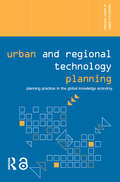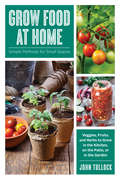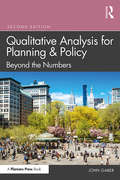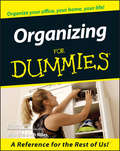- Table View
- List View
The Handbook of Interior Design
by Jo Ann Asher Thompson Nancy H. BlossomThe Handbook of Interior Design explores ways of thinking that inform the discipline of interior design. It challenges readers to consider the connections within theory, research, and practice and the critical underpinnings that have shaped interior design. Offers a theory of interior design by moving beyond a descriptive approach to the discipline to a 'why and how' study of interiors Provides a full overview of the most current Interior Design research and scholarly thought from around the world Explores examples of research designs and methodological approaches that are applicable to interior design upper division and graduate education courses Brings together an international team of contributors, including well established scholars alongside emerging voices in the field – reflecting mature and emergent ideas, research, and philosophies in the field Exemplifies where interior design sits in its maturation as a discipline and profession through inclusion of diverse authors, topics, and ideas
History of Interior Design
by John Pile Judith GuraThis classic reference presents the history of interior design from prehistory to the present. Exploring a broad range of design styles and movements, this revised and expanded edition includes coverage of non-Western design and vernacular interior architecture and features 665 photographs and drawings (color and black-and-white). A History of Interior Design is an essential resource for practicing and aspiring professionals in interior design, art history, and architecture, and general readers interested in design and the decorative arts.
The Gardener's Botanical: An Encyclopedia of Latin Plant Names - with More than 5,000 Entries
by The Gardener's B Ross BaytonThe definitive guide to botanical Latin. Unlock the secrets of botanical Latin with this beautifully illustrated encyclopedia. The Gardener's Botanical contains definitions of more than 5,000 plant names—from abbreviatus ("shortened") to zonatus ("with bands")—along with more than 350 color illustrations. Scientific plant names are an invaluable tool for those who understand them. Formed from Greek and, more commonly, from Latin root words, not only do they make it possible for gardeners and botanists to communicate, they also contain a wealth of hidden information. The Gardener's Botanical is the key to unlocking these secrets. This guide contains a breathtaking array of botanical names in alphabetical order. Each word is listed with a pronunciation guide, definition, example plant, and, where appropriate, etymology. Also included in this illuminating guide are special features on important plant genera, fact boxes, essays focusing on the history and importance of Latin names and botanical illustrations, and an index of common names with more than 2,000 popular plants, cross-referenced with their binomial name in Latin.
Household Hints For Dummies, Pocket Edition
by Janet SobeskyClean your homethe easy way! The best ways to clean today are different from what they were even a few years ago. It's not just that you have to know how to use new products and new equipment. The surfaces in your home and the fibers used to make clothes and furniture have improved. Plus, the time you have to clean has shrunk. Inside you'll find easy-to-follow information on stain removal and a room-by-room guide to cleaning up everything from counters to carpets. You'll cut down on expensive cleaning bills and still maintain your home. Open the book and find: The basics of having a clean house The right tools for the job Methods for busting dust Tips on cleaning floors and carpets Guidance on caring for your kitchen and bathroom Hints on doing your laundry
Printmaking: How to Print Anything on Everything
by Christine MedleyBefore the digital age, printing was a handcraft — and it still is! This guide presents 12 easy-to-follow projects that demonstrate time-honored techniques for decorating gift bags and coasters, transferring images to mugs and t-shirts, and embellishing other items. Suitable for crafters at all levels of ability and of all ages, the projects employ common household items such as cardboard tubes, cork, and rubber erasers. More than 100 photographs accompany complete directions for the easy and accessible process of relief printing: creating a stencil, inking it up, applying the stencil to the item, and then repeating. An introduction to tools, materials, and equipment is followed by chapters on making your own toolbox, creating art with found and natural objects, printing with your own custom stamps and plates, screen printing and photographic techniques, and more. Each project features helpful tips for turning out a high-quality product and suggestions for adding personal touches.
Interior Design Illustrated
by Francis D. Ching Corky BinggeliThe bestselling guide to interior design, updated with new code and technology Interior Design Illustrated is the definitive guide to design for interior spaces. Richly illustrated in author Francis Ching’s signature style, this book introduces complex design concepts in a visually stunning format; from defining the space and using the elements of design, to planning building systems and incorporating sustainable materials, this volume embodies the idea that beauty and function are not separate entities, but two parts of a whole. This new fourth edition has been updated to reflect the latest building codes and design practices, with discussion of new materials related to acoustics, lighting, and sustainable furnishings. Renewed attention to sustainability includes new information on energy conservation, design for longevity and adaptive reuse of existing buildings, as well as an updated discussion on LED lighting, workplace design, use of color, and computer modeling software to provide a well-rounded view of how interior design firms are working today. This classic text brings the elements and principles of design to life, giving students the practical skills they need to transition from idea to concept. Understand the latest building codes and how to integrate them into your design Explore new advances in materials, lighting, and wireless technology Design from a perspective of sustainability, longevity, and energy efficiency Delve into BIM, including software for modeling lighting, acoustics, and more Interior designers work at the intersection of aesthetics, functionality, regulations, accessibility, sustainability, and technology. There’s no one formula for getting it right, only an eye trained by experience, based on a mastery of design fundamentals. Interior Design Illustrated begins laying that foundation, guided by a leading global authority in the field.
Interior Design for Autism from Adulthood to Geriatrics (Wiley E-book Design Shorts)
by A. J. Paron-WildesWhen designing spaces for individuals with Autism, there are specific design strategies that can be employed to create optimal spaces that can have a positive impact on special learning and sensory needs. Interior Design for Austism from Adulthood to Geriatrics gives designers the exact information they need to implement these design strategies in their own projects. Projects covered relate specifically to the age ranges from adulthood through geriatric age, including workplaces, clinical settings, and nursing homes. The main neurofunctions of Autism are covered along with specific design techniques that can be used to address each one. Information on toxins and material selection is also included.
Interior Design for Autism from Childhood to Adolescence (Wiley E-book Design Shorts)
by A. J. Paron-WildesWhen designing spaces for individuals with Autism, there are specific design strategies that can be employed to create optimal spaces that can have a positive impact on special learning and sensory needs. Interior Design for Autism from Childhood to Adolescence gives designers the exact information they need to implement these design strategies in their own projects. Projects covered relate specifically to the age ranges from childhood through adolescence, including high schools, residential group homes, and workplaces. The main neurofunctions of Autism are covered along with specific design techniques that can be used to address each one. Information on toxins and material selection is also included.
The Interior Design Business Handbook: A Complete Guide to Profitability
by Mary V. KnackstedtThousands of interior design professionals have come to rely on The Interior Design Business Handbook for comprehensive, accessible coverage of the essential procedures, tools, and techniques necessary to manage a successful interior design business. The Fifth Edition of this essential resource has been revised to address the latest trends and changes in the field, with new and updated material on business size and structure, building a brand, client development, social networking and Internet marketing, finances, purchasing, technology and software programs, and other key areas. Complete with more than 75 sample forms and letters, this Fifth Edition is a one-stop resource for all aspects of establishing and running an interior design business—from choosing a location and managing day-to-day operations to growing a business and putting it up for sale. All of the techniques and procedures in the book are rooted in real-world experience and are used daily in successful design firms throughout the United States. Filled with valuable information for solo practices and small firms as well as larger businesses, this book is an indispensable resource for seasoned professionals as well as interior designers who are at the start of their career.
Learning from Bryant Park: Revitalizing Cities, Towns, and Public Spaces
by Andrew M. ManshelBy the 1970s, 42nd Street in New York was widely perceived to be unsafe, a neighborhood thought to be populated largely by drug dealers, porn shops, and muggers. But in 1979, civic leaders developed a long-term vision for revitalizing one especially blighted block, Bryant Park. The reopening of the park in the 1990s helped inject new vitality into midtown Manhattan and served as a model for many other downtown revitalization projects. So what about urban policy can we learn from Bryant Park? In this new book, Andrew M. Manshel draws from both urbanist theory and his first-hand experiences as a urban public space developer and manager who worked on Bryant Park and later applied its strategies to an equally successful redevelopment project in a very different New York neighborhood: Jamaica, Queens. He candidly describes what does (and doesn’t) work when coordinating urban redevelopment projects, giving special attention to each of the many details that must be carefully observed and balanced, from encouraging economic development to fostering creative communities to delivering appropriate services to the homeless. Learning from Bryant Park is thus essential reading for anyone who cares about giving new energy to downtowns and public spaces.
The Interior Design Productivity Toolbox: Checklists and Best Practices to Manage Your Workflow
by Phyllis HarbingerGet organized and streamline your workflow with this A-Z accountability system. Design is only part of an interior designer’s job—you’re also responsible for scheduling client meetings, conducting design surveys, creating drawings and specs, and overseeing installation. Multiply by the number of projects on your plate, and you have a recipe for overwhelming disorganization. The Interior Design Productivity Toolbox helps you juggle multiple projects with ease, with a comprehensive self-management system tailored to the needs of interior designers and decorators. Features include: Detailed checklists that highlight weak spots and warn against common pitfalls Covers residential design, contract design, specifications, and renovations Best practices for meetings, design surveys, drawings, specifications, and renovations Customizable online checklists for tracking every phase of your project Exclusive online budgeting tool for tracking product costs and associated expenses to share with your team and your clients If you need to get organized and get back to work, you need The Interior Design Productivity Toolbox.
Lighting Design Basics
by Mark Karlen Christina Spangler James R. BenyaA visual, real-world guide to professional lighting design Lighting Design Basics is the essential guide to this basic, but difficult-to-master aspect of interior design. Offering fundamental concepts and prescriptive techniques in a highly visual format, this book provides clear, practical guidance on utilizing the latest in lighting techniques and technology to showcase a space without sacrificing utility. Covering more than 25 different design scenarios with in-depth rationale for proposed solutions, this book provides insightful distribution diagrams, floor plans, and details for lighting installation and construction. Real-world case studies illustrate lighting design in residential, commercial, healthcare, education, and hospitality settings, and skill-building exercises offer practice for real-world projects as well as NCIDQ and NCARB exam preparation. This new third edition includes new instructor support materials, coverage of computer calculation software, and in-depth discussion on the latest in LED lighting. Lighting is changing, both in the technology itself, and in the way a designer must approach it. This book provides immersive instruction through real-world settings, and practical guidance suited for immediate application in everyday projects. Get up-to-date on the latest methods and technology for lighting design Examine more than 25 design scenarios for different types of spaces Complete exercises to hone your skills or prepare for the NCIDQ or NCARB Create simple lighting designs and collaborate with architects on complex projects Lighting can make or break a space. Improper lighting lends a space an uncomfortable feel, can induce headaches or eyestrain, and can even be hazardous—but thoughtfully designed and executed lighting adds that extra element so often missing from typical spaces. Lighting Design Basics shows you how to elevate any space through the fundamental tools and concepts of professional lighting design.
Medical and Dental Space Planning: A Comprehensive Guide to Design, Equipment, and Clinical Procedures
by Jain MalkinTHE UPDATED DEFINITIVE REFERENCE ON MEDICAL AND DENTAL OFFICE DESIGN Medical and Dental Space Planning is an indispensable guide to the myriad of details that make a medical or dental practice efficient and productive. The unique needs of more than thirty specialties, as well as primary care, are explained in the context of new technology and the many regulatory and compliance issues influencing design. Concepts are also presented for ambulatory surgical centers, diagnostic imaging, clinical laboratories, breast care clinics, endoscopy centers, community health centers, radiation oncology, and single-specialty and multispecialty group practices and clinics. A thorough review of the latest dental technology and many creative space plans and design ideas for each dental specialty will be of interest to both dentists and design professionals. Important topics like infection control are top of mind, influencing every aspect of dental office design. An "inside look" at what goes on in each specialist's office will familiarize readers with medical and dental procedures, how they are executed, and the types of equipment used. Technology has radically impacted medical and dental practice: digital radiography, electronic health records, mobile health devices, point-of-care diagnostic testing, digital diagnostic instrumentation, CAD/CAM systems for digital dental impressions and milling of restorations in the dentist's office, portable handheld X-ray, and 3D cone beam computed tomography for dentists all have major implications for facility design. The influence of the Affordable Care Act is transforming primary care from volume-based to value-based, which has an impact on the design of facilities, resulting in team collaboration spaces, larger consultative examination/assessment rooms, and accommodation for multidisciplinary practitioners who proactively manage patient care, often in a patient-centered medical home context. The wealth of information in this book is organized to make it easy to use and practical. Program tables accompany each medical and dental specialty to help the designer compute the number and sizes of required rooms and total square footage for each practice. This handy reference can be used during interviews for a "reality check" on a client's program or during space planning. Other features, for example, help untangle the web of compliance and code issues governing office-based surgery. Illustrated with more than 600 photographs and drawings, Medical and Dental Space Planning is an essential tool for interior designers and architects as well as dentists, physicians, and practice management consultants.
Planning Twentieth Century Capital Cities (Planning, History and Environment Series)
by David GordonThe twentieth century witnessed an unprecedented increase in the number of capital cities worldwide – in 1900 there were only about forty, but by 2000 there were more than two hundred. And this, surely, is reason enough for a book devoted to the planning and development of capital cities in the twentieth century. However, the focus here is not only on recently created capitals. Indeed, the case studies which make up the core of the book show that, while very different, the development of London or Rome presents as great a challenge to planners and politicians as the design and building of Brasília or Chandigarh. Put simply, this book sets out to explore what makes capital cities different from other cities, why their planning is unique, and why there is such variety from one city to another. Sir Peter Hall’s ‘Seven Types of Capital City’ and Lawrence Vale’s ‘The Urban Design of Twentieth Century Capital Cities’ provide the setting for the fifteen case studies which follow – Paris, Moscow and St Petersburg, Helsinki, London, Tokyo, Washington, Canberra, Ottawa-Hull, Brasília, New Delhi, Berlin, Rome, Chandigarh, Brussels, New York. To bring the book to a close Peter Hall looks to the future of capital cities in the twenty-first century. For anyone with an interest in urban planning and design, architectural, planning and urban history, urban geography, or simply capital cities and why they are what they are, Planning Twentieth Century Capital Cities will be the key source book for a long time to come.
Housing Transformations: Shaping the Space of Twenty-First Century Living (Housing and Society Series)
by Bridget FranklinDrawing together a wide range of literature, this original book combines social theory with elements from the built environment disciplines to provide insight into how and why we build places and dwell in spaces that are at once contradictory, confining, liberating and illuminating. This groundbreaking book deals with topical issues, which are helpfully divided into two parts. The first presents a conceptual framework examining how the built environment derives from a variety of influences: structural, institutional, textual, and action-orientated. Using illustrated case study examples, the second part covers new build schemes, including urban villages, gated communities, foyers, retirement homes and televillages, as well as refurbishment projects, such as mental hospitals and tower blocks. Multidisciplinary in its focus, Housing Transformations will appeal to academics, students and professionals in the fields of housing, planning, architecture and urban design, as well as to social scientists with an interest in housing.
The Emergence of the Interior: Architecture, Modernity, Domesticity
by Charles RiceTaking a radical position counter to many previous histories and theories of the interior, domesticity and the home, The Emergence of the Interior considers how the concept and experience of the domestic interior have been formed from the beginning of the nineteenth century. It considers the interior's emergence in relation to the thinking of Walter Benjamin and Sigmund Freud, and, through case studies, in architecture's trajectories toward modernism. The book argues that the interior emerged with a sense of 'doubleness', being understood and experienced as both a spatial and an image-based condition. Incorporating perspectives from architecture, critical history and theory, and psychoanalysis, The Emergence of the Interior will be of interest to academics and students of the history and theory of architecture and design, social history, and cultural studies.
Sustainable Urban Development Volume 1: The Framework and Protocols for Environmental Assessment (Sustainable Urban Development Series #Vol. 1)
by Steven Curwell Mark Deakin Martin SymesBased on original research, this first volume of a set of groundbreaking new books sets out a framework for analyzing sustainable urban development and develops a set of protocols for evaluating the sustainability of urban development. Protocols included are for sustainable urban planning, urban property development, urban design, the construction, operation and use of buildings. Using these protocols, the book goes on to provide a directory of environmental assessment methods for evaluating the sustainability of urban development and also maps out how these assessment methods are being transformed to evaluate the environmental, economic and social sustainability of urban development. Web-based applications are increasingly being used to support this transformation and the contributors deftly cover this application and issues concerning the use of information and communication technologies for evaluating the sustainability of urban development are also dealt with. With its multidisciplinary approach, Sustainable Urban Development presents key new material for postgraduates and professionals across the built environment.
Mobile Technologies of the City (Networked Cities Series)
by Mimi Sheller John UrryMobile communications technologies are taking off across the world, while urban transportation and surveillance systems are also being rebuilt and updated. Emergent practices of physical, informational and communicational mobility are reconfiguring patterns of movement, co-presence, social exclusion and security across many urban contexts. This book brings together a carefully selected group of innovative case studies of these mobile technologies of the city, tracing the emergence of both new socio-technical practices of the city and of a new theoretical paradigm for mobilities research.
Framing Strategic Urban Projects: Learning from current experiences in European urban regions
by Willem Salet Enrico GualiniPresenting the findings of extensive research into the development of planning tools and strategies since the early 1970s, this book addresses key issues in urban development/governance and brings together a range of different national experiences. Helpfully divided into three sections, Framing Strategic Urban Projects sets out the study framework, with its social, policy and institutional contexts; uses up-to-date European case studies to highlight different planning issues, including new-urbanism, information networks and public partnerships; and finally makes good-practice recommendations. Offering a systematic comparison of a wide variety of projects and providing useful case study material of these large-scale urban projects and recommendations, this book is essential reading for planners, policy makers and students interested in how to make strategic urban projects work effectively.
Creating Child Friendly Cities: New Perspectives and Prospects
by Brendan Gleeson Neil SipeFirst Published in 2006. Routledge is an imprint of Taylor & Francis, an informa company.
Planning at the Landscape Scale (RTPI Library Series #Vol. 12)
by Paul SelmanTraditionally, landscape planning has involved the designation and protection of exceptional countryside. However, whilst this still remains important, there is a growing recognition of the multi-functionality of rural areas, and the need to encourage sustainable use of the whole countryside rather than just its ‘hotspots’. With an inter-disciplinary assessment of the rural environment, this book draws on theories of landscape values, people-place relationships, sustainable development, and plan implementation. It focuses on the competing influences of globalization and localization, seeing the role of planning as the reconciliation of these conflicting demands, reinforcing character and distinctiveness without museum-izing rural areas. Taking a ‘landscape scale’ approach to the topic, this book responds to the interest sparked by concern for rural landscapes and by recent local and national policy shifts in this area.
Urban and Regional Technology Planning: Planning Practice in the Global Knowledge Economy (Networked Cities Series)
by Kenneth E. Corey Mark WilsonPart of the popular Networked Cities series, Urban and Regional Technology Planning focuses on the practice of relational planning and the stimulation of local city-regional scale development planning in the context of the global knowledge economy and network society. Designed to offer scholars, practitioners, and decision makers studies on the ways of cities, technologies, and multiple forms of urban movement intersect and create the contemporary urban environment, Kenneth Corey and Mark Wilson explore the dynamics of technology-induced change that is taking place within the context of the global knowledge economy and network society. Examining first the knowledge economy itself, Wilson and Corey go on to discuss its implications before proposing ways to strategize for future intelligent development, with particular emphasis on the ALERT model for regional and local planning. An important read for those practicing or studying planning in this network society.
Grow Food at Home: Simple Methods For Small Spaces
by John TullockEverything you need to know to grow good food without a yard Grow food for freshness. Grow food organically. Grow food to connect with nature. Whatever the goal, you don’t need a lot of space to enjoy the benefits of homegrown veggies, herbs, and fruits. In Grow Food at Home, gardening expert John Tullock shows readers just how easy it is to enjoy “farm”-fresh produce grown right on the windowsill, the porch, or in a tiny backyard. Covering artificial lighting, hydroponics, vertical gardening, straw-bale planters, and more, the book offers even the most confined apartment dwellers plenty of options to get growing. Tullock shares all the tips and tricks readers need to make small-space gardening a success, with information on starting seeds, transplanting, succession planting, “crop” rotation, and other procedures—all tailored to the small-space garden—plus recipes to make the most of the harvest. Readers will be energized to grow a mouth-watering selection of micro-crops, from lettuces and herbs to tomatoes, cucumbers, beets, and even small fruits—no matter how little room they have available.
Qualitative Analysis for Planning & Policy: Beyond the Numbers
by John GaberThe revised and updated second edition of Qualitative Analysis for Planning & Policy is a roadmap to help planners access qualitative data and integrate it into their planning investigations. Planning and policy decisions are not based solely on numbers, and this book equips planners with a how-to guide to see what has been missing "between the lines" of quantitative data and make good decisions using the best possible information. Each chapter offers step-by-step instruction on how to set up and enact diverse types of qualitative research, and case studies demonstrate how qualitative research techniques can be combined with quantitative methods to tackle complex real-world projects. For over a decade Qualitative Analysis for Planning & Policy has been an indispensable resource for students and researchers, experienced and novice planners. The revised second edition offers myriad tools to help twenty-first-century planners make intelligent decisions, including new qualitative research techniques, technological innovations, and contemporary case studies.
Organizing For Dummies (For Dummies Ser.)
by Eileen Roth Elizabeth MilesWhat’s the favorite four-letter word of people who are less than fully organized? “Help!” So many technological, social, and economic changes affect your life that you need organization just to keep up, let alone advance. Many people have two jobs – one at the office and one taking care of things at home. If you have a family, you may count that as a third job. Caring for elderly relatives or have community commitments? You can count off four, five, and keep right on going. No matter what life stage you’re in, getting organized can make every day better and help you achieve your long-term goals. Organizing For Dummies is for anyone who wants to Polish his or her professional reputation Experience less stress Increase productivity Build better relationships Maximize personal time Organization isn’t inherited. With the human genome decoded, the evidence is clear: DNA strings dedicated to putting things into place and managing your time like a pro are nonexistent. Instead, organization is a learned skill set. Organizing For Dummies helps you gain that skill with topics such as: Understanding how clutter costs you in time, money, and health Training your mind to be organized and developing a plan Cleaning house, room by room, from basement to attic (including the garage) Creating functional space for efficiency and storage Time-management strategies for home, office, and tavel Scheduling, delegating, and multitasking Making time for your family Managing your health – physical and financial Finding time for love Organizing and cashing in on a great garage sale Getting organized is about unstuffing your life, clearing out the dead weight in places from your closet to your calendar to your computer, and then installing systems that keep the good stuff in its place. Organizing is a liberating and enlightening experience that can enhance your effectiveness and lessen your stress every day – and it’s all yours simply for saying “No” to clutter.
